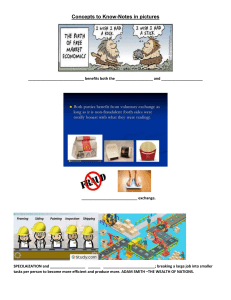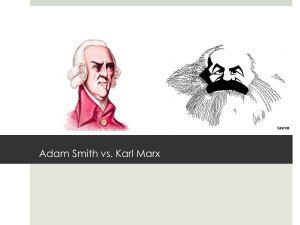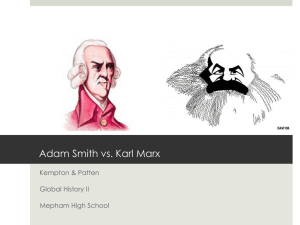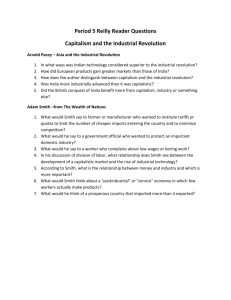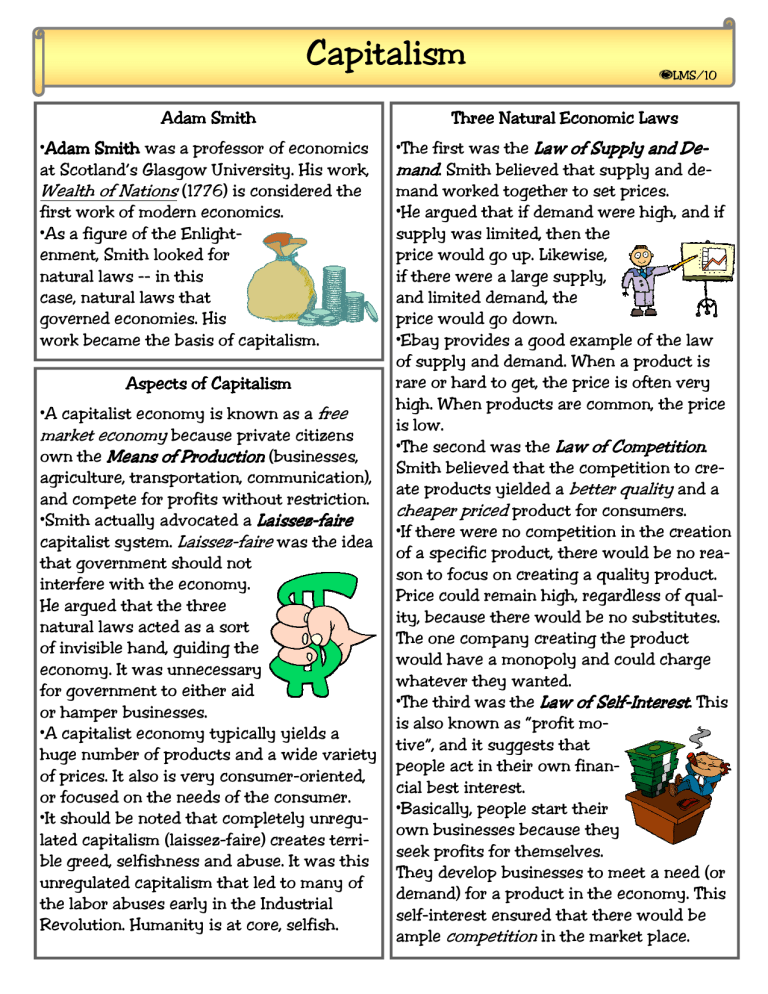
Capitalism SLMS/10 Adam Smith Three Natural Economic Laws •Adam Adam Smith was a professor of economics at Scotland’s Glasgow University. His work, Wealth of Nations (1776) is considered the first work of modern economics. •As a figure of the Enlightenment, Smith looked for natural laws -- in this case, natural laws that governed economies. His work became the basis of capitalism. •The first was the Law of Supply and Demand. Smith believed that supply and demand worked together to set prices. •He argued that if demand were high, and if supply was limited, then the price would go up. Likewise, if there were a large supply, and limited demand, the price would go down. •Ebay provides a good example of the law of supply and demand. When a product is rare or hard to get, the price is often very high. When products are common, the price is low. •The second was the Law of Competition. Smith believed that the competition to create products yielded a better quality and a cheaper priced product for consumers. •If there were no competition in the creation of a specific product, there would be no reason to focus on creating a quality product. Price could remain high, regardless of quality, because there would be no substitutes. The one company creating the product would have a monopoly and could charge whatever they wanted. •The third was the Law of Self Self--Interest. This is also known as “profit motive”, and it suggests that people act in their own financial best interest. •Basically, people start their own businesses because they seek profits for themselves. They develop businesses to meet a need (or demand) for a product in the economy. This self-interest ensured that there would be ample competition in the market place. Aspects of Capitalism •A capitalist economy is known as a free market economy because private citizens own the Means of Production (businesses, agriculture, transportation, communication), and compete for profits without restriction. •Smith actually advocated a Laissez Laissez--faire capitalist system. Laissez-faire was the idea that government should not interfere with the economy. He argued that the three natural laws acted as a sort of invisible hand, guiding the economy. It was unnecessary for government to either aid or hamper businesses. •A capitalist economy typically yields a huge number of products and a wide variety of prices. It also is very consumer-oriented, or focused on the needs of the consumer. •It should be noted that completely unregulated capitalism (laissez-faire) creates terrible greed, selfishness and abuse. It was this unregulated capitalism that led to many of the labor abuses early in the Industrial Revolution. Humanity is at core, selfish. Global History Capitalism 1. Who was Adam Smith? 2. What was Smith’s contribution to history? Name _____________________________________ 7. What did Smith say happened when there was no competition? 8. What is behind the Law of Self-Interest? 3. What did the Law of Supply and Demand do? 9.Why does this law help ensure competition in the economy? 4. How did this law work? 10. Define: Means of Production -- 11. Why is capitalism known as a free market economy? 5. Give your own example of Supply and Demand in action. 12. What is laissez-faire capitalism? 6. What is the idea behind the Law of Competition? 13. What are the advantages and disadvantages of capitalism? Global History Capitalism Key Name _____________________________________ 1. Who was Adam Smith? Price could remain high, regardless of qualA professor of economics at Scotland’s Glas- ity, because there would be no substitutes. The one company creating the product would gow University have a monopoly and could charge whatever they wanted. 2. What was Smith’s contribution to history? His work, Wealth of Nations (1776) is consid- 8. What is behind the Law of Self-Interest? ered the first work of modern economics. His Also known as “profit motive”, and it sugwork became the basis of capitalism. gests that people act in their own financial best interest. 3. What did the Law of Supply and Demand 9.Why does this law help ensure competition do? Smith believed that supply and demand in the economy? People start their own businesses because worked together to set prices. they seek profits for themselves. They de4. How did this law work? velop businesses to meet a need, and this enHe argued that if demand were high, and if sured that there would be ample competition supply was limited, then the price would go in the market place. up. Likewise, if there were a large supply, and limited demand, the price would go down. 10. Define: Means of Production -- all the businesses, agriculture, transportation & 5. Give your own example of Supply and De- communication systems mand in action. Answers will vary. A good example is always 11. Why is capitalism known as a free market that hot toy at Christmas time (THE toy var- economy? ies from year to year), or video gaming plat- Because private citizens own the Means of forms. These are purchased at one price, then Production and compete for profits without placed on ebay for a higher price because restriction. they are scarce and in high demand. 12. What is laissez-faire capitalism? 6. What is the idea behind the Law of Com- Laissez-faire was the idea that government petition? should not interfere with the economy. Smith believed that the competition to create products yielded a better quality and a 13. What are the advantages and disadvantages of capitalism? cheaper priced product for consumers. A capitalist economy typically yields a huge 7. What did Smith say happened when there number of products and a wide variety of was no competition? prices. It also is very consumer-oriented, or If there were no competition in the creation focused on the needs of the consumer. Unof a specific product, there would be no rea- regulated capitalism (laissez-faire) creates terrible greed, selfishness and abuse. son to focus on creating a quality product. Legal Disclaimers Thank you for your purchase. If you found this work useful, please consider rating this work and purchasing other readings by the same author. Also, please consider recommending this author’s work to your colleagues. ©2010 Lauri Secker: The Lady Lion. All rights reserved. Reproduction of this work in another form, in part or in whole, is prohibited. Purchase of this unit entitles the purchaser the right to reproduce the pages in limited quantities for classroom use only. Duplication for an entire school, an entire school system or commercial purposes is strictly forbidden without written permission from the publisher. Electronic distribution limited to classroom use only. All images are property of Jupiterimages and are licensed for use in this work only. Any other use of these images without proper license is unauthorized and prohibited. For licensing information, see www.clipart.com

